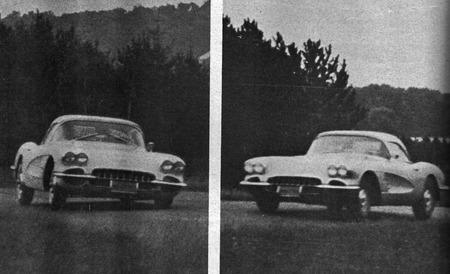Originally published in Sports Cars Illustrated in December 1958.
On the H-D brake kit, thirty-six pounds are eliminated by knocking out the air duct to the rear brakes. The front scoop now directs air to the front brakes, which were somewhat blanketed by the body panels that were widened last year. “Elephant ears” now cope with such problems at the rear.
For testing purposes we were again allowed to run riot on the Ride Road. This is a twisting, narrow road that every last one of us would be delighted to have in his backyard. Our first run was in a much modified Impala; but more about that some other time.
Next sample was the ’59 bodied, ’58 chassis boulevard sports car style of Corvette. Briefly, even with the mild, mild engine, wheelspin was a real problem on smooth blacktop starts. On more frictionful surfaces, wheel hop replaced wheelspin. There’s a wide gap between first and second gear ratios, but with such a mild engine, the Corvette pulls easily in second from very low revs. At the west end of our little race course is a bend of about 600 feet radius. It goes around and around, about 225° in fact, but at the end there are some rather mean dips and rises. Staying in second for this one, we found that the car rolls considerably and that occasionally it would “run out of gas.” The float chamber was being tilted too much. When leaving the dip we came down to earth in a solid fashion. The suspension bottomed out with a thud, but remarkably the Corvette held to its course, though displaced sideways a bit.
The other car was Duntov’s Gray Ghost, and an impressive machine it was. The clutch was set up for short travel, correspondingly the pedal forces are slightly increased. Combined with the more forceful response of the 290 hp mill to the throttle, the whole set-up has a much more purposeful, taut feel. We had only made two passes before a torrent of rain deluged us, but the improvement in handling was eye-opening. It was much more level when cornering, had quicker steering, and it had consistent response to the throttle no matter what the attitude of the car.
The latter is most important in a car this powerful, for once the back end has started to “hang out,” much if not most of the steering is done with the throttle rather than the wheel. Even in the rain this H-D Corvette showed remarkable stability. Some credit should go to the Firestone SS170 tires, but only some. They grip exceedingly well up to a point, but when you press on still harder it’s almost like driving on ice. These were not the latest 170-T’s mentioned elsewhere in this issue, incidentally.
The sintered metallic brakes on this car were strikingly unobtrusive. It was only after a dozen laps of our “circuit” that the constant spray of water chilled them enough that they became a bit touchy. Strictly a temperature effect, as inorganic linings do not absorb water.
Despite the commendable lightness of control, the Corvette, even in racing trim, seems to be an awful lot of automobile to jockey around a narrow road circuit at racing speeds. Despite its shortcomings, it is, as we said last year, hard to beat on the basis of performance per dollar of original investment. Though tire wear will keep running costs up, the “extensive use” of American parts should more than offset this. And if you are buying a Corvette with the intention of racing it, it is naturally cheaper to get it with the full factory-installed kit of racing gear than to try to bring a lesser car up to racing specs yourself.


Leave a Reply